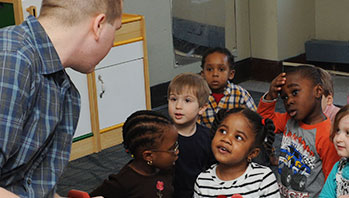- chart paper
- marker
- high
- loud
- loudest
- low
- pitch
- soft
- softest
- volume
MA Standards:
Speaking and Listening: SL.PK.MA.1 Participate in collaborative conversations with diverse partners during daily routines and play.
Language: L.PK.MA.1 Demonstrate use of oral language in informal everyday activities.
Language: L.PK.MA.6 Use words and phrases acquired through conversations, listening to books read aloud, activities, and play.
MA Draft STE Standards:
Physical Sciences/Energy PS4.B Apply their understanding in their play of how to change volume and pitch of some sounds.
Head Start Outcomes:
Language Development/Receptive Language Attends to language during conversations, songs, stories, or other learning experiences.
Language Development/Expressive Language Uses language to express ideas and needs.
PreK Learning Guidelines:
English Language Arts/Language 2 Participate actively in discussions, listen to the ideas of others, and ask and answer relevant questions.
Talk Together: High and Low

© Commonwealth of Massachusetts, Department of Early Education and Care (Jennifer Waddell photographer). All rights reserved.
STEM Key Concepts: Sounds vary in volume (loud or soft) and pitch (high or low)
ELA Focus Skills: Listening and Speaking, Vocabulary
Tell children you want them to say “good morning” in their softest voice. Then have them say it in their loudest voice. Remind them that they are changing the volume of their voice when they say something loud and then soft. Ask, What is another way you can change the sound of your voice? Allow children to respond. If they don’t recall pitch, say (in a high voice), Let’s sing it with a very high voice. Then sing it in a low voice.
Then tell children you are going to change the pitch of your voice, that is, how high and low it is, as you read them a poem. Say, Listen to the differences in the way my voice sounds as I recite this poem.
Bird’s Lullaby
Listen, listen and you’ll hear (cup your hand around your ear)
The chirping song of birds nearby
Some birds sing low (drop your hands as you sing a low pitch)
Some birds sing high (raise your hands you sing a high pitch)
To make a sweet, sweet lullaby.
Recite the poem a second time and have children join in using a high voice and a low voice (pitch). Then challenge them to experiment and recite the poem in a loud and then a soft voice (volume).
Ask children to name something that makes a high pitch/low pitch sound. (fire alarm, truck bell, baby’s cry/dog’s growl, rumbling thunder, car motor) Record these sounds on a “High/Low” chart. Draw an upward facing arrow next to things that make a high pitch sound and a downward arrow next to things that make a low pitch sound.
Adaptation: The concept of pitch can be very difficult for young children to understand and produce. They may confuse pitch with volume or not be able to discriminate high and low sounds easily. Play High/Low games often with your voices or classroom instruments to develop this concept.
